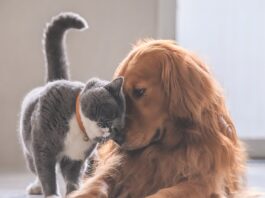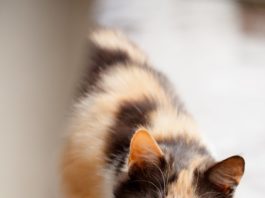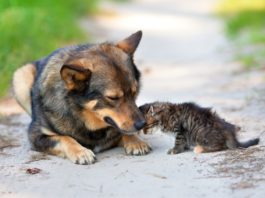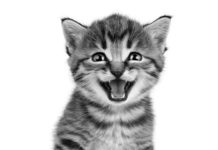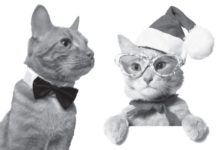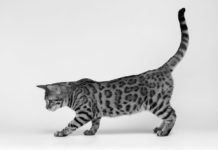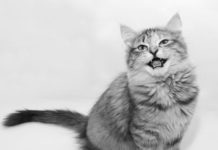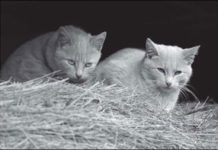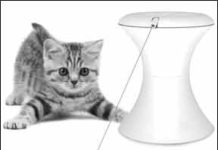Cats’ Behavior Affected Crucially Early in Life
Most of us recognize obvious signs of stress and anxiety in our cats - taking up residence under the bed being high on the list - but we may not be aware of more subtle signs, such as lowering the head and eyes, lifting a paw and staring at middle distance. These are among nearly 40 behaviors that may require intervention, according to the American Animal Hospital Associations 2015 Canine and Feline Behavior Management Guidelines, published this past summer. Behavioral problems affect more dogs and cats than any other medical condition and are one of the most common causes of euthanasia, relinquishment or abandonment of pets, the association says, adding that their management is essential in veterinary practice. It urges a culture of kindness that avoids the use of forced restraint.
The Pros and Cons of Holiday Costumes
There are pros and cons in dressing up pets, says Allen Schoen, DVM, Ph.D., a pioneer in integrative animal health care and author of Kindred Spirits: How the Remarkable Bond Between Humans and Animals Can Change the Way We Live. Dressing up pets is an opportunity for some people to just be joyful, fun loving and it brings the child out in us. It can increase our laughter, which is all positive in supporting our overall health and immune system, but care must be taken to make sure that the pet also enjoys being dressed up.
8 Simple Steps to Stopping Pica
Prevent access to tempting items by hiding them. Even if your cat doesnt have pica, its a wise idea to keep items like yarn, rubber bands, and tinsel and Venetian blind cords out of reach. Instead, offer a variety of safer toys.
When Rough Play Gets Out of Hand
Your indoor cat needs and deserves daily play sessions to keep him physically and mentally fit. Play can help prevent him from engaging in destructive behaviors like shredding the sofa out of boredom or becoming obese from overeating to pass the time.
The Many Reasons for the Cats Meow
Meowing can be endearing, but lets face it: When our cats meow to excess, it can sometimes drive us crazy. The same sort of meowing that is not a problem at 6 p.m. can be a huge problem at 4 a.m. when the owner is trying to sleep, says behaviorist Katherine A. Houpt, VMD, Ph.D., professor emeritus at Cornell University College of Veterinary Medicine. What cat owners consider excessive meowing in cats depends largely on what time of day it is.
Singles Turn to Pets for a Sense of Family
An intriguing trend has developed among singles in the U.S. Single people — men particularly — are becoming pet owners at rates greater than families. They’re “turning to pets for love and a sense of family,” according to a survey by the American Veterinary Medical Association. In a five-year period, pet ownership among the never married, widowed and divorced grew 16.6 percent. Excluding people who never married, growth in pet ownership among singles rose 17.7 percent during this same period.
Study Puts Feral Cats in the Spotlight
A study published earlier this year that found free-ranging cats annually kill an estimated 2.4 billion birds and more than 20 million mammals drew heated responses from both wildlife and cat advocates.Lost in the controversy was the plight of outdoor cats themselves. They suffer from exposure to extreme weather and more injuries caused by cars, dogs, other cats and wild animals than those who live indoors, says Bruce G. Kornreich, DVM, Ph.D., Associate Director for Education and Outreach at the Feline Health Center at the Cornell University College of Veterinary Medicine.
Ask Elizabeth: July 2013
I completely understand your thoughts on this matter, as recent developments have caused many owners (and cats … believe it or not!) to reconsider their habits and the effects that their lifestyle may have on native populations. The recent study suggesting that domestic cats are contributing to the demise of billions of birds and small mammals points out the fact that the interaction of domestic species with native wildlife is an important issue, one that requires careful thought and action.
Why Do They … Chase Lasers Beams?
Cats love to chase lasers’ points of light, twirling, leaping, pouncing. They engage in the behavior with gleeful abandon for one simple reason: “The jumpy, erratic movement of the light beam can stimulate predatory-like play behavior,” says Pamela Perry, DVM, Ph.D., a lecturer in animal behavior at the Cornell University College of Veterinary Medicine.
Why Do They Chase Lasers Beams?
Cats love to chase lasers’ points of light, twirling, leaping, pouncing. They engage in the behavior with gleeful abandon for one simple reason: “The jumpy, erratic movement of the light beam can stimulate predatory-like play behavior,” says Pamela Perry, DVM, Ph.D., a lecturer in animal behavior at the Cornell University College of Veterinary Medicine.
Ask Elizabeth: May 2013
Thank you so much for recognizing how adorable it is when we cock our heads to one side. We’re only trying to look cute when we do this … it really serves no function. I’m kidding, although I’d have to think about this, which makes me want to tilt my head to the side, too! Seriously, though, this behavior is to be distinguished from the dramatic tilting of the head that may suggest an inner ear infection (the inner ear is important for the maintenance of balance) or that may be seen when cats have ear mites or an external ear infection. Cats with abnormalities of the brain, including tumors, may also tilt their heads to one side, and any cat who demonstrates persistent head tilt and/or shaking of the head should be evaluated by a veterinarian promptly.
Smart Tactics to Stop Destructive Chewing
Pipper loved to lick plastic and crawled eagerly into every plastic bag she could find. But the longhaired black cat’s fascination with plastic eventually progressed to a big problem — chewing the plastic and ingesting tiny pieces to the alarm of her owner, Pamela Perry, DVM, Ph.D., a lecturer in animal behavior at the Cornell University College of Veterinary Medicine. While some dogs chew sundry objects from shoes to sofa legs, cats tend to focus on houseplants, thread, string, yarn and electrical cords. Some, though, like Pipper, chew plastic, and Dr. Perry reached a turning point with the threat to her cat’s health. Ingested plastic could lead to an intestinal blockage. “I had to make sure that all plastic bags were put away,” she says. “They had to be well-hidden or she would find a way to get them.”


